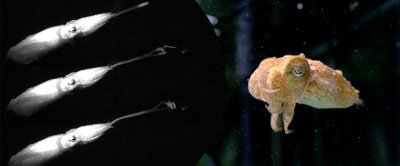
Onderwerp scriptie
Prey capture by the dwarf cuttlefish
Cuttlefish are versatile predators capable of attaching to a variety of prey items within milliseconds. They do this by rapidly extending their paired tentacle stalks, which terminate in clubs equipped with arrays of suction cups. Cuttlefish rely on secure and quick attachment to prey for successful hunting and feeding.
But how do these arrays of suction cups work together to attach so quickly and which factors might influence this behaviour? We use 3D highspeed videography to study this hunting behaviour closely. One long term goal is developing cephalopod inspired grippers that can attach to a range of substrates. Analysing the in vivo preloading of suction cups as well as the function of the suction cup array on the tentacle club can help inform these designs. Furthermore, it can contribute to understanding the ecology of a generalist predator.
We are looking for motivated students (Master thesis or 24 ECTS Bachelor thesis) who are interested in studying the mechanics and behaviour of prey capture by the dwarf cuttlefish (Ascarosepion bandense) using highspeed video. You will be learning how to train the animals to perform tentacle strikes in our setup, and how to record and analyse highspeed video footage. Depending on the research question and your interests you might also be modifying the setup, can write some code for data analysis or design objects for the cuttlefish to interact with.
Skills you will be using/learning are:
- Designing/modifying experimental setups
- Training cuttlefish for experiments
- (3D) highspeed video recording
- Video tracking using machine learning
- Data analysis in Python
If you are interested in this topic and want to learn a range of cool techniques, do not hesitate to contact us via ezo.thesis@wur.nl to ask for the options.

